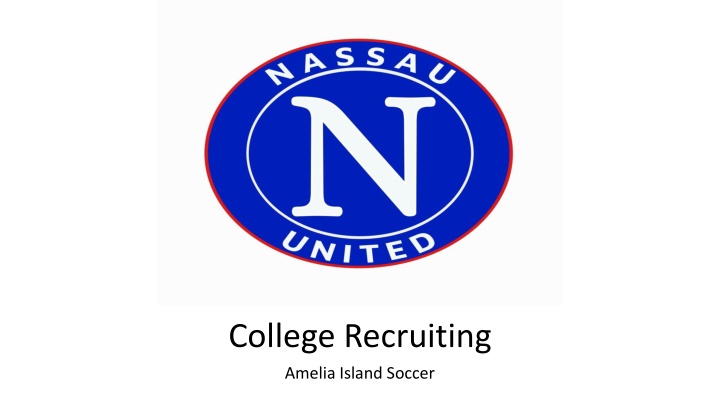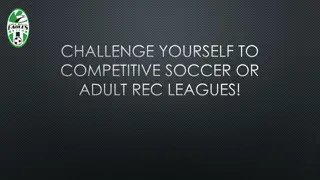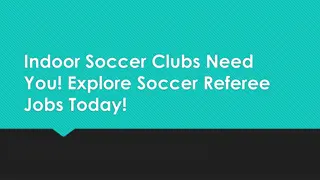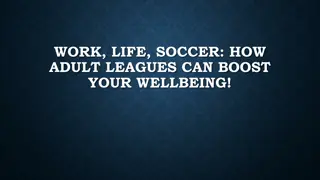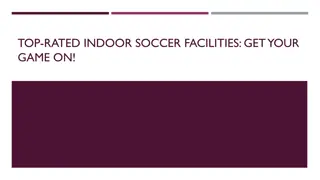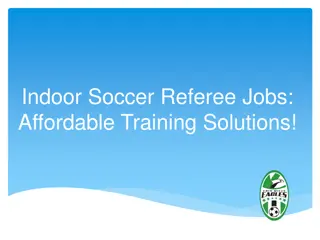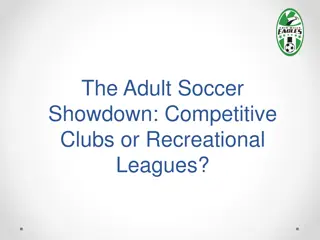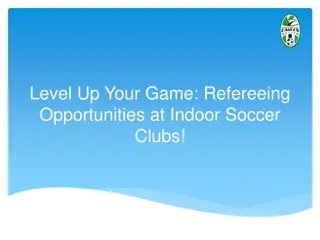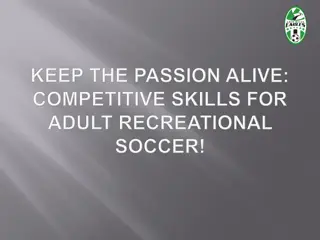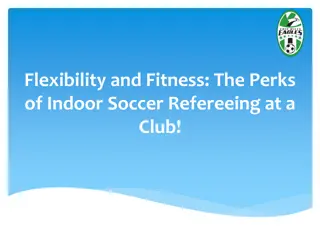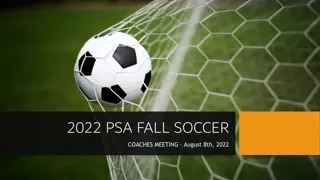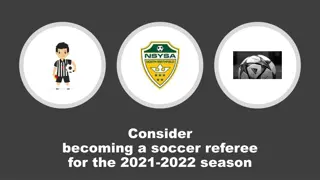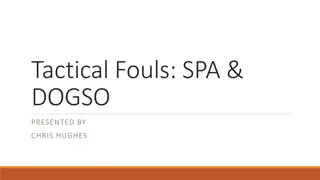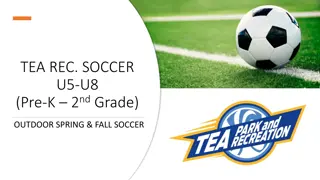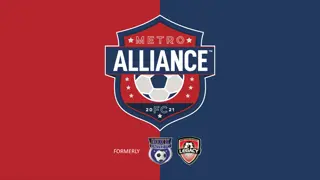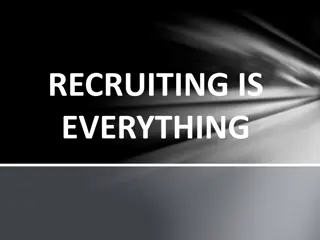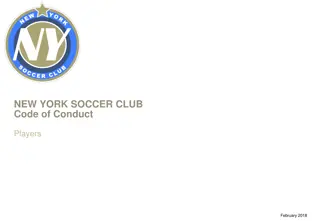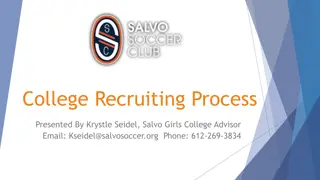Comprehensive Guide to College Recruiting for Soccer Players
This detailed guide covers essential aspects of college recruiting for soccer players, including getting started, suggested timelines, umbrella organizations like NCAA and NAIA, eligibility requirements, and tips for successful recruitment. It emphasizes the importance of academic eligibility, communication with coaches, and narrowing down school choices to find the right fit. Valuable insights are shared to help aspiring athletes navigate the recruiting process effectively.
Download Presentation

Please find below an Image/Link to download the presentation.
The content on the website is provided AS IS for your information and personal use only. It may not be sold, licensed, or shared on other websites without obtaining consent from the author.If you encounter any issues during the download, it is possible that the publisher has removed the file from their server.
You are allowed to download the files provided on this website for personal or commercial use, subject to the condition that they are used lawfully. All files are the property of their respective owners.
The content on the website is provided AS IS for your information and personal use only. It may not be sold, licensed, or shared on other websites without obtaining consent from the author.
E N D
Presentation Transcript
College Recruiting Amelia Island Soccer
Agenda Getting Started Atmosphere Academics/Scholarships Communication Additional Resources
Getting Started Atmosphere Academics/Scholarships Communication Additional Resources Getting Started
Suggested Timelines Suggested Timelines Timelines below can vary by school and male/female athletes* Freshman-Soph Year Soph-Junior Year Junior-Senior Year Determine your realistic level of Majority of players make Athletes write to a large number of schools to state your interest play commitments Narrow your school list down to List of schools should be narrowed Visit campuses those that have the right fit (~15) to 3-5 If you are not getting communication from coaches, shift focus elsewhere Club coach can help to be liaison if college coaches show interest Discuss with parents the financial aspects
Umbrella Organizations Umbrella Organizations Other NCAA Division I/II NCAA Division III NAIA or NJCAA
Umbrella Organizations Umbrella Organizations Eligibility Center is the organization within the NCAA that determines the academic eligibility and amateur status for all NCAA DI and DII athletes You need to register and be cleared by the NCAA if you want to play NCAA college sports and receive a scholarship at the DI or DII level Cost for registration is $90 for US citizens Create an account and make payment High School submits official transcripts SAT or ACT testing center sends official test results Answer amateur status questionnaire Once everything above is completed, NCAA will not review your information unless it has been requested by an NCAA University If you have registered with the NCAA and have not had your eligibility status completed, chances are it has not been requested by a coach Over 60% of athletes who are registered with the NCAA are never recruited by a college coach
Coaches Communication Coaches Communication Division I & II Freshman & Sophomore Year Prospect can send unlimited emails, texts, and make phone calls Prospect can receive camp or clinic invitations After 1 Sept of Junior Year Coaches can get involved with a recruit s unofficial visit Recruits can start taking official visits Recruits & college coaches can have recruiting conversations during camps Coaches can make phone calls and send direct emails Division III Contact prospects at any time during high school
Getting Started Atmosphere Academics/Scholarships Communication Additional Resources Atmosphere
What to Consider What to Consider
Where Do You Fit Where Do You Fit
Division I Statistics Division I Statistics Girls Statistics 9.7% of U.S. high school players end up playing collegiately 2.3% end up playing Division I 3% of college recruits are international players 7.9% of U.S. high school players end up playing collegiately 1.1% end up playing Division I 21.3% of college recruits are international players Boys Statistics *Based on a 2017 study done by NCSA (ncsasports.org). Trend towards international recruits is growing.
Do Your Research Do Your Research Make a list of potential schools Research these schools Campus visits Online Resources Spend some time researching how to write a good letter to coaches
Getting Started Atmosphere Academics/Scholarships Communication Additional Resources Academics & Scholarships
Academics Academics Academics need to be the FIRST priority Freshman-Senior years focus on good grades and good SAT/ACT scores Coaches are looking for recruits who can balance school and sports Make certain to research schools with your major Recommend taking the PSAT in your freshman or sophomore year. Take the SAT and/or ACT no later than the end of your junior year these are important to help predict your opportunity for merit based scholarships Everyone should complete a FAFSA application. Don t assume you don t qualify! Complete Oct of your senior year, using prior year tax information.
Scholarships Scholarships Division I/II schools offer a variety of athletic scholarships - Fully funded athletic scholarship - Partial athletic scholarship - Combined athletic and academic - Academic Division III does not offer athletic scholarships Division I fully funded schools have ~9.9 scholarships for men and ~14 for women (average rosters include 28-29 players) Division II fully funded schools have 9 scholarships for men and 9.9 for women NAIA schools can offer up to 12 fully funded athletic scholarships Junior Colleges can offer up to 18 fully funded athletic scholarships Not all schools are fully funded All Divisions offer Financial and Merit-based scholarships
Getting Started Atmosphere Academics/Scholarships Communication Additional Resources Communications
Contacting Schools Contacting Schools
Athletes vs Parents Athletes vs Parents Step aside parents coaches want to hear from the athletes Coaches are more impressed when . Recruits speak more than the parents Recruits are the point person for email and phone communication Recruits are asking the questions versus parents
Where to Start Where to Start Don t be overwhelmed! Here s how to start: 2-3 weeks before every tournament, check online for the college coaches that are attending Send emails to several different coaches expressing interest and inviting them to see you play - Write to a variety of schools, not only the 1-2 you ve heard of before - Cast a wide net: Writing 5 schools is better than nothing but writing 15-20 is ideal Make sure you include: - Your schedule/ game times/ team name - Your jersey number and position - Your HS graduation year - Your club coaches contact info Follow up after your tournament to see if they had a chance to see you play, and express your interest again Schools that are interested will contact you! Determine if you are potentially interested in that school, based on the other factors - If possibly interested, keep the communication going! - If not interested, thank them for their interest, but advise you aren t overly interested. Start writing coaches in your sophomore year, but don t be upset if you don t get responses
Additional Resources Additional Resources NCAA Eligibility Center https://web3.ncaa.org/ecwr3/ NCAA Eligibility Center FAQ https://ncaa.egain.cloud/kb/EligibilityHelp/home NCAA Eligibility Center Registration Checklist http://fs.ncaa.org/Docs/eligibility_center/Student_Resources/Registration_Checklist.pdf NCAA Division I Eligibility Standards http://www.ncaa.org/student-athletes/play-division-i-sports NCAA Division II Eligibility Standards http://www.ncaa.org/student-athletes/play-division-ii-sports NCAA Recruiting Fact Sheet http://www.ncaa.org/sites/default/files/Recruiting%20Fact%20Sheet%20WEB.pdf
